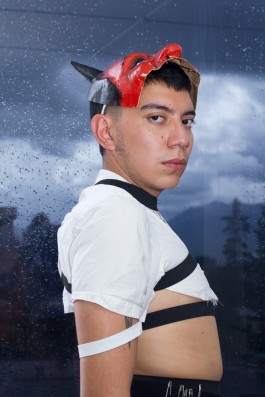





In Ecuador there is the small town of Pillaro in the province of Tungurahua near Ambato. There the festival `Diablada de Píllaro´ is celebrated at the beginning of the year from January 1st to January 6th. According to history, the indigenous population disguised itself as a demonic creature during the colonial period, as a symbol of the devil, in order to resist the proselytization of the Catholic faith and the physical, economic and moral abuse they received from the Spaniards. There are different stories about the origins of today's festival. It is also not possible to determine exactly how long this festival has already existed. The practice of putting on a mask of the devil that resembles the creature that the colonialists themselves feared most, and of dancing to mockery, is for gaining control over evil or the enemy. On the other hand, for many religious colonialists, the indigenous, according to their ideas, “unbelieving people” themselves represented the presence of the devil. It is about a kind of appropriation, to become the depiction of the devil in order to frighten the enemy or even to flee to beat.
The portrait shows a young man from Cuenca, Ecuador, who chose the clothes he wears. In his gender identity he often does not feel clearly, sometimes very feminine, sometimes more androgynous in nature. It is difficult for him to freely live out his sexuality or another definition of his own gender role in a very conservative Catholic country. The mask of the devil that he wears in the photos is also symbolic for me for the rejection of social norms, showing resistance and one's own liberation from social norms.

El oponente (Gegenspieler), Photography, 2020

Enfrentar la Realidad (Sich der Realität stellen), Photography, 2020

Mirrar a otro lado (Wegschauen), Photography, 2020

Mephisto, Photography, 2020

Tus pies toco en la sombra (Ihre Füße berühren sich im Schatten), photography, 2020

El alma duerme (die Seele schläft), Photography, 2020
In Ecuador gibt es die kleine Stadt Pillaro in der Provinz von Tungurahua in der Nähe von Ambato. Dort wird bis heute immer zu Beginn des Jahres von 1. bis zum 6. Januar das Fest `Diablada de Píllaro´ gefeiert. Der Geschichte nach verkleidete die indigene Bevölkerung während der Kolonialzeit sich als demonische Kreatur, als Sinnbild des Teufels, um Widerstand gegen die Missionierung zum katholischen Glauben und gegen physische, wirtschaftliche und moralische Misshandlung zu leisten, welche sie von den Spaniern erhielten. Es gibt verschiedene Geschichten zur Herkunft des heutigen Festes. Auch ist nicht genau zeitlich einordbar, wie lange dieses heutige Fest bereits existiert.
Die Praxis sich eine Maske des Teufels überzustülpen, die dem Wesen ähnelt, wovor sich die Kolonialisten selbst am meisten fürchteten, und zum Spott zu tanzen, gilt zur Erlangung der Kontrolle über das Böse oder den Feind. Zum anderen Teil stellte für viele religiöse Kolonialisten das indigene nach ihren Vorstellungen `ungläubige Volk´ selbst die Präsenz des Teufels dar. Es geht um eine Art von Aneignung, selbst die Verbildlichung des Teufels zu werden, um den Feind zu erschrecken oder sogar in die Flucht zu schlagen.
Das Portrait zeigt einen jungen Mann aus Cuenca Ecuador, die Kleidung die er trägt wählte er selbst aus. In seiner Geschlechtsidentität fühlt er sich oft nicht eindeutig, manchmal sehr weiblich, manchmal im Wesen mehr androgyn. Es ist für ihn schwierig in einem sehr konservativen katholisch geprägten Land seine Sexualität oder eine andere Definition der eigenen Geschlechterrolle frei ausleben zu können. Die Maske des Teufels die er auf den Fotos trägt, steht für mich auch symbolisch für Ablehnung von Gesellschaftsnormen, zeigen von Resistenz und eigene Befreiung von gesellschaftlichen Normativen.